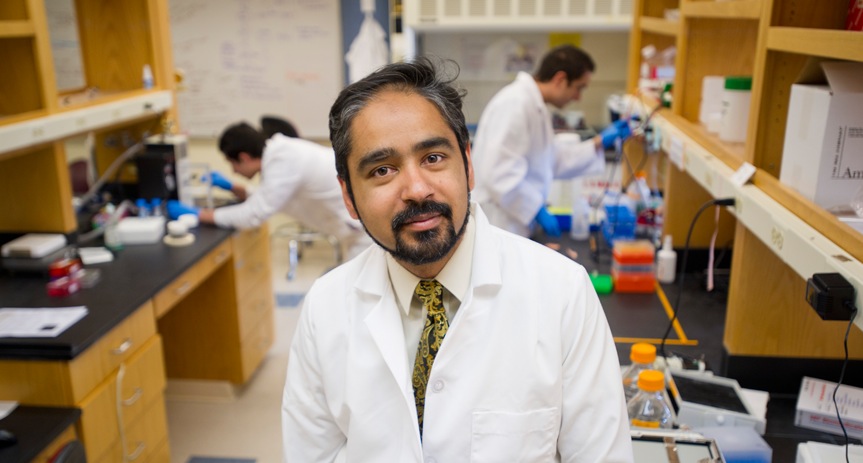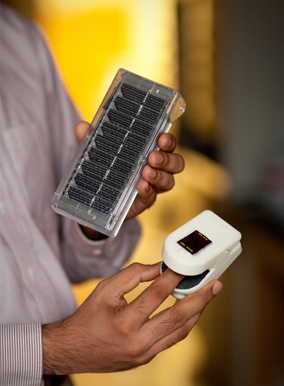Video
Muhammad Zaman talks about developing a cheap and durable device for health workers in rural Zambia that measures blood oxygen levels. The pulse oximeter could help save many of the one million children who die of pneumonia each year. Video by Devin Hahn
Most of us have seen a pulse oximeter in hospitals—it’s the small device, only an inch or two long, that the nurse clips on your fingertip to measure your blood oxygen level. Muhammad Zaman’s version isn’t nearly as sleek, but it may change the face of global health care.
Designed for health workers in rural Zambia, Zaman’s pulse oximeter is a clunky white block about the size of a computer mouse, molded from thick plastic and about as stylish as a pair of nurses’ shoes. But when compared to the standard American hospital-grade oximeter, Zaman’s is a marvel of durability and function. It’s cheap, sturdy, and as he likes to say, “Zambia-ready.”
“These may not be the coolest, cutting-edge devices,” says Zaman, a College of Engineering associate professor of biomedical engineering. “They’re not, and they aren’t supposed to be. We are concerned about very basic problems.” Namely, how to save a million children a year from dying of pneumonia. More often than not for the developing world, you need the Doc Martens, not the Manolo Blahniks.
Zaman understands this as well as anyone. He is a biomedical engineer with a rare set of gifts: technical skill, verbal eloquence, irrepressible enthusiasm, and an innate understanding of the developing world. A native of Pakistan, Zaman knows firsthand the “atrocious” state of health care in much of the world, which is one reason he is committed to building low-cost medical devices for poor countries. The pulse oximeter was just his first creation; he is also developing low-cost devices to diagnose HIV and uncover counterfeit drugs. In July, he was awarded a USAID/Gates Foundation Saving Lives at Birth Grant of $250,000 for two years to develop a user-friendly and cost-effective device to screen for counterfeit and substandard drugs. Public health experts estimate that in parts of Africa, Asia, and Latin America as much as 30 percent of drugs sold are counterfeit and 50 percent of antimalarials are substandard.
With his passion and commitment, Zaman evokes comparisons to Paul Farmer, the visionary Harvard physician and founder of the non-profit Partners In Health, who is famous in public health circles for bringing medical care to some of the poorest parts of the world. Zaman’s colleagues, however, say that the comparison is not quite accurate. “Paul Farmer is a charismatic, evangelical leader,” says Jonathon Simon, director of BU’s Center for Global Health & Development and a School of Public Health professor and chair of the department of international health. “Muhammad has all that passion plus the rigorous science. He’s Paul plus.”
Zaman has his work cut out for him in trying to solve health care problems in the developing world. The history of global health is littered with well-intentioned failures: expensive machines that nobody needs, nobody wants, or nobody knows how to fix.
Zaman’s pulse oximeter is designed to help diagnose pneumonia in children in the developing world. More than a million children under five die of pneumonia every year, according to the World Health Organization (WHO), making it the single biggest killer of children worldwide. But pneumonia is also curable. “We have the right drugs for the right bugs,” says Simon. If a sick child gets to a hospital with antibiotics, oxygen, and a critical care unit, she will probably be fine.
So why do so many kids die? Either they never get to the hospital or they get there too late. Currently, in rural undeveloped areas, community health workers diagnose pneumonia by looking for visual signals: rapid breathing and a deep, sucking intake of breath. With a cheap and durable pulse oximeter, they could make diagnoses far more quickly and accurately. But pulse oximeters are neither cheap nor durable. A hospital-grade oximeter can cost hundreds of dollars and be fairly fragile: one misplaced footstep will crunch it into oblivion.

Muhammad Zaman directs a lab whose goal is not only to create medical devices for the developing world, but to reform engineering education in those countries as well.
Finding the Holy Grail
Enter Zaman, who was drawn to BU from the University of Texas in 2009 partly by the promise of collaboration with the University’s medical and public health schools. Simon, knowing Zaman’s interest in technologies for the developing world, approached him with his problem. “I asked him, ‘Can you build a pulse oximeter that’s cheap and sturdy enough for a community health worker in Zambia?’” Simon recalls. “Sure,” replied Zaman. “What’s a pulse oximeter?”
This is a hallmark of Zaman’s career: the ability to go from total ignorance of a subject to mastery in a few months. Zaman posted a notice, looking for biomedical engineering students to build an oximeter for their senior design project. “Three brilliant seniors came to me,” he says, “because I was able to write, ‘This is something transformative for Zambia. This is not just another project.’”
He chose Matthew Fleming (ENG’10, MED’14), Bryan Lublin (ENG’10), and Max Condren (ENG’10), and the team got to work, meeting with Simon for an afternoon of brainstorming. The public health guys told the engineers what they needed: the oximeter couldn’t run off the electrical grid—it had to be wind-up or solar- or battery-powered. It had to cost less than $100, fit both adults and newborns, and work in temperatures up to 104 degrees Fahrenheit. And because most community health workers travel by bicycle on bumpy roads, “you needed to be able to bounce the heck out of it,” says Simon. The advisors also gave the engineers a Nokia cell phone common in Africa to examine and cannibalize.
Zaman asked questions and took notes. Four months later, the team had a working prototype, and a year later, a finished product. “We set design parameters that we thought would keep him busy and out of our hair for three or four years,” says Simon. “But he turned it around in a year. In a year!”
Zaman credits his three students for the success of the oximeter, which won the 2010 award for best biomedical engineering senior design project. But clearly his energy, enthusiasm, and commitment drove the project. “I had a lot of aha moments on the project, suddenly realizing that this guy is an all-star,” says Lublin. “He was really excited about everything and got us excited, too.”
Muhammad Zaman hopes to stem the flow of counterfeit medicines to Africa, Asia, and Latin America.
The pulse oximeter now rests in the hands of Amy Canham, a research fellow in Zaman’s Lab for Engineering Education & Development (LEED). Canham is wiring the computer chip for the heart of the next-generation device and hopes to begin field-testing in Zambia this fall. Several groups are racing to build such a device, and the dominant invention will almost certainly change the face of global health. “Low-cost oximeters will have traction, not just for pneumonia, but also for surgery,” says Simon. “A low-cost, robust oximeter is the Holy Grail.”
Zaman knows, however, that Holy Grails aren’t effective unless people can use them. So he actively promotes “capacity building”—creating institutions in the developing world to train the technologists and engineers of tomorrow. “A few years ago I went to Lusaka, the capital of Zambia, a major city with millions of people,” he says. “I was surprised to find that there were only three people who maintained all hospital equipment for the whole city. If one of them dies, then you have two. Millions of dollars of equipment are donated to places like this every year.” How, he wonders, can Western professors like him help build technical expertise and innovation in a place like Zambia?
Zaman’s lab seeks to answer that question. LEED’s goal is not only to create medical devices for the developing world, but to reform engineering education in those countries as well. “When people talk about engineering education, they don’t talk about engineering education in Zambia,” he says. “We need to create schools of engineering and schools of medicine across the world.”
Zaman is collaborating with the United Nations Economic Commission for Africa to help Zambia, Kenya, Uganda, and Ethiopia develop bioengineering curricula, and his work has gained international attention. “He’s really passionate about it,” says Adriana Velazquez Berumen, WHO coordinator of diagnostic imaging and medical devices. “He knows it’s not just about creating a new device, but creating a new profession.”
“You need to make indigenous capacity,” says Zaman, “and I get it. More than many other people in engineering, I get it.”
Many people who know Zaman suspect that he doesn’t sleep much, given his penchant for 4 a.m. emails and his astounding output. Now 34, he directs a lab of 25 people who advance his flourishing research on both cancer biology and low-cost medical devices. He also writes a science blog for the Huffington Post and advises the BU student chapter of Engineers Without Borders.
But he considers himself first and foremost an academic. He enjoys teaching and is an engaging lecturer who respects his students and listens to their opinions. “I came from a family of teachers,” says Zaman, “and I just was tremendously grateful for what my father and mother had left me with—this sense of tremendous responsibility that comes with teaching.” ■

Comments
On 29 March 2013 at 6:57 AM, Mazhar Hussain wrote:
I heard a PhD student of Zaman today at Lahore. Found the work interesting for the service of mankind.
On 25 January 2013 at 12:52 PM, Hycienth Ahaneku (SPH’08) wrote:
"Impressive" is the word. Just simply impressive.
On 24 January 2013 at 12:16 PM, Abdurahman Adan (SPH’01) wrote:
Zaman’s design for this small and affordable pulse oximeter is to be a graat put to the worldwide efforts of saving the more than a million children under five die of pneumonia every year.
Public Health Specialist
Jijiga, Ethiopia
On 24 January 2013 at 10:41 AM, Ben (SMG’03) wrote:
Great to see the BU community profiling such entrepreneurs and their efforts to engage parts of the world like Africa. As a graduate from the school of Management, I have spent the past 5 years building a network of entrepreneurs and investors focused on enterprise development on the continent. The BU community is welcome to join us at VC4Africa.
Post Your Comment